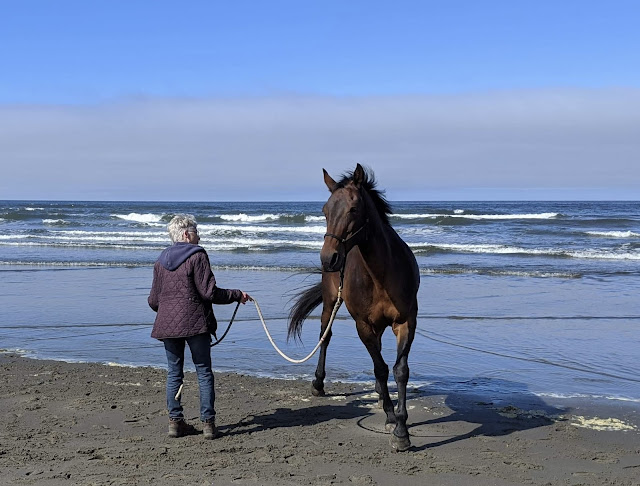 |
| Elise and Blackie, no stirrups, one rein, connecting through feel. |
By Mary Gallagher
In light of last month’s article on achieving balance and freedom of movement, minus restricting tack, this month I want to talk about taking away the reins and stirrups.
Yes, you read me right. Riders rely too much on reins and stirrups for balance, dulling their horses’ natural abilities to connect and communicate through feel.
Our Hoof Beats youth riding program (and many of our adult students) has long since adopted the ‘No Stirrup November’ practice popular with many trainers and riding schools. What initially seemed challenging has become a fun—the kids are naturals at finding the connection with their horses based on balance and feel, whether using bareback pad, saddle sans stirrups, or neither. By December, their return to stirrups reveals much-improved equitation and a deeper bond between horse and rider.
This year I decided to take it up a notch, to No Stirrups
and No Reins November. Our goal: to ride with no bridle by the end of the month.
So far, so good. One week in, everyone is getting comfortable riding with one rein—actually a lead rope attached to a rope halter —and one stick, but as the month progresses we aim to ride with no reins, two sticks or one. Some of our advanced riders, see Elise, above, are getting quite comfortable at all gaits, even jumping with one rein.
Beyond the thrill of realizing how well we and our horses can communicate without traditional tack, the point of this process is to bring us into better synchronization with the horse, training our bodies through strong focus and better understanding of body language.
Here’s how it works:
The idea is to essentially
mirror what we want our horses to be doing.
Basically, any time we get on our horse, we have a plan, our horse has a plan, and it is up to us to get our horse to buy into
our plan. But without stirrups or reins, it is
crucial that we understand his plan in the process.
When the reins disappear, we develop a heightened awareness for what our horse is thinking and preparing to act on, and it can be a little scary. Whether it is a slight drift to the gate, or a mental distraction that may lead to a spook, we feel it instantly, but without reins, we quickly realize the need to get his mind and body back on track before it develops into the latter.
This is a good thing—riding without reins or stirrups give us a very clear picture of what is not working and needs to be cleaned up, because in the normal course of riding with the usual tack, we are far more likely to allow more distraction in our horse. Without reins and stirrups, we very quickly learn just how effective our balance, seat, and leg aids are in holding our horse’s interest and attention!
 |
| Wendy and Zeus, communicating at the trot. |
So, this month is all about becoming more aware of where the horse needs our weight and balance to be, in order to stay in balance himself.
We are learning to use our focus, seat, and leg aids to connect to the horses' feet. First at the halt, with isolations, turns on the forehand, turns on the hind quarters, stepping forward, backing up, and sideways movements. Also, learning to flip the rein from one side to the other, without changing our balance. Lots of practice, lots of practice, lots of practice.
As we master all of these movements at the halt, we then apply these same communications as we progress into a walk, then a trot, and finally, the canter. Any difficulties at each stage sends us back to the basics; success at each gait depends success at the previous stage—there’s no faking it as we move forward!
 |
| Asking for a step back... |
 |
| ...got it! Ellie and Harriot relax. |
I should note that success at rein-less/stirrup-less riding is definitely not about gripping with the knees or keeping a tight grip on the rope, both of which interfere with the type and level of communication we are seeking. Crucially, success here is about balance and effective communication, which require neither reins nor stirrups.
I am very excited to see how our young and adult riders fare over No Stirrups or Reins November! I expect everybody to realize quite an upgrade in their ability to connect, communicate, and cooperate with their horses.
Stay tuned for my report in December!






















